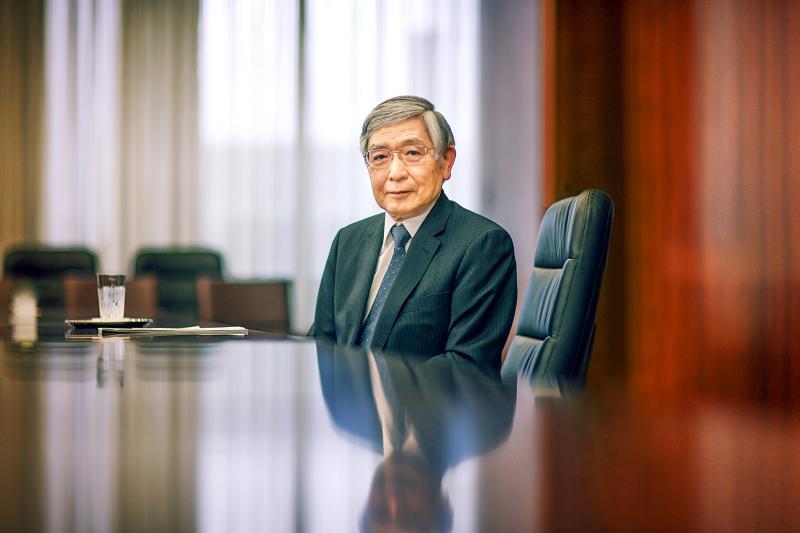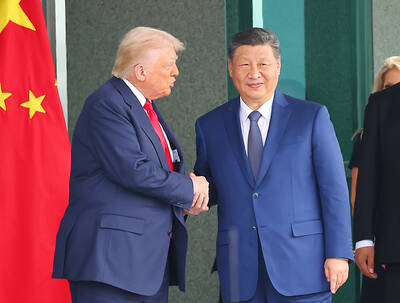The Bank of Japan will consider climate change in its monetary policy discussions, Governor Haruhiko Kuroda said on Thursday.
“We have a great interest” in climate change, and its impact on the economy and the financial system, Kuroda said in an interview. “Naturally, how we respond to this at the level of monetary policy will become a topic of discussion.”
The comments come amid growing debate among central bankers over whether or how they should support efforts to counter climate change, following a series of pledges by governments, including the US, China and Japan, to reduce greenhouse emissions.

Photo: Bloomberg
Touching on another key theme among investors, Kuroda said that global inflation concerns were most relevant in the US.
US Federal Reserve Chair Jerome Powell has said that some temporary inflation pressures will prove transitory and stimulus should stay in place for longer.
“That policy stance is based on the recognition that it will take time to overcome low inflation once it is entrenched,” Kuroda said. “That is the lesson learned from Japan’s experience of prolonged deflation.”
Until now, Kuroda has largely stuck to the view that the Bank of Japan needs to consider climate change from the perspective of how it might present a risk to the financial system, a stance similar to Powell’s.
While his latest remarks suggest he might be moving in the direction of European Central Bank President Christine Lagarde or Bank of England Governor Andrew Bailey, who have shown a more aggressive stance on green issues, it remains to be seen what action the Bank of Japan will take.
“While there are discussions about whether central banks should be buying green bonds, many of those discussions are over asset management, not monetary policy,” Kuroda said, when asked whether Japan’s central bank would consider purchasing green bonds as a response to climate change.
Targeting green bonds is an approach Lagarde has had difficulty moving forward. Kuroda did not rule out using new loan incentives that the bank launched in March.
Kuroda, Powell, Bailey and Lagarde are to be among those discussing ways to promote green financing measures at next week’s Green Swan Conference organized by the Bank for International Settlements, the IMF and others.
Interest is growing in how the Bank of Japan might support the nation’s pledge last month to reduce emissions by 46 percent by 2030 on its way to becoming carbon neutral by 2050.
Eighty-three percent of economists surveyed by Bloomberg last month said that the Bank of Japan will end up using its new lending incentives to promote environmental, social and corporate governance, or higher growth policies.
The incentives essentially pay commercial banks different interest rates on their reserves depending on the type of lending they provide for businesses.
The incentives were intended to give the bank more scope for lowering its policy rate, not as a possible tool for responding to climate change, Kuroda said.
However, they could be adapted, he said.
As for inflation and signs that the tide of central banks is starting to signal a move away from the emergency policy measures of the COVID-19 pandemic, Kuroda once again underlined that the Bank of Japan would keep its stimulus rolling.
“Each central bank has to adapt its monetary policy to its own economy, price and financial situations,” Kuroda said. “Our inflation rate is still quite low and so we have to be persistent in conducting our monetary easing to achieve our 2 percent price stability target.”

RUN IT BACK: A succesful first project working with hyperscalers to design chips encouraged MediaTek to start a second project, aiming to hit stride in 2028 MediaTek Inc (聯發科), the world’s biggest smartphone chip supplier, yesterday said it is engaging a second hyperscaler to help design artificial intelligence (AI) accelerators used in data centers following a similar project expected to generate revenue streams soon. The first AI accelerator project is to bring in US$1 billion revenue next year and several billion US dollars more in 2027, MediaTek chief executive officer Rick Tsai (蔡力行) told a virtual investor conference yesterday. The second AI accelerator project is expected to contribute to revenue beginning in 2028, Tsai said. MediaTek yesterday raised its revenue forecast for the global AI accelerator used

TEMPORARY TRUCE: China has made concessions to ease rare earth trade controls, among others, while Washington holds fire on a 100% tariff on all Chinese goods China is effectively suspending implementation of additional export controls on rare earth metals and terminating investigations targeting US companies in the semiconductor supply chain, the White House announced. The White House on Saturday issued a fact sheet outlining some details of the trade pact agreed to earlier in the week by US President Donald Trump and Chinese President Xi Jinping (習近平) that aimed to ease tensions between the world’s two largest economies. Under the deal, China is to issue general licenses valid for exports of rare earths, gallium, germanium, antimony and graphite “for the benefit of US end users and their suppliers

Dutch chipmaker Nexperia BV’s China unit yesterday said that it had established sufficient inventories of finished goods and works-in-progress, and that its supply chain remained secure and stable after its parent halted wafer supplies. The Dutch company suspended supplies of wafers to its Chinese assembly plant a week ago, calling it “a direct consequence of the local management’s recent failure to comply with the agreed contractual payment terms,” Reuters reported on Friday last week. Its China unit called Nexperia’s suspension “unilateral” and “extremely irresponsible,” adding that the Dutch parent’s claim about contractual payment was “misleading and highly deceptive,” according to a statement

Artificial intelligence (AI) giant Nvidia Corp’s most advanced chips would be reserved for US companies and kept out of China and other countries, US President Donald Trump said. During an interview that aired on Sunday on CBS’ 60 Minutes program and in comments to reporters aboard Air Force One, Trump said only US customers should have access to the top-end Blackwell chips offered by Nvidia, the world’s most valuable company by market capitalization. “The most advanced, we will not let anybody have them other than the United States,” he told CBS, echoing remarks made earlier to reporters as he returned to Washington